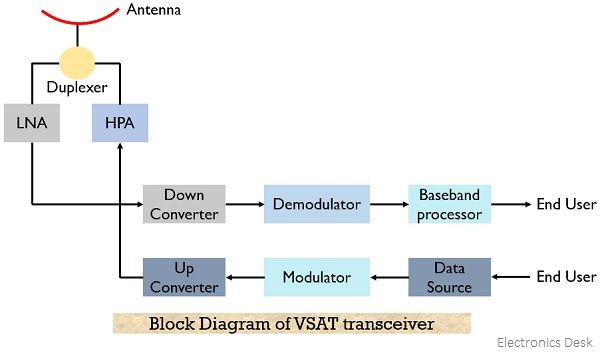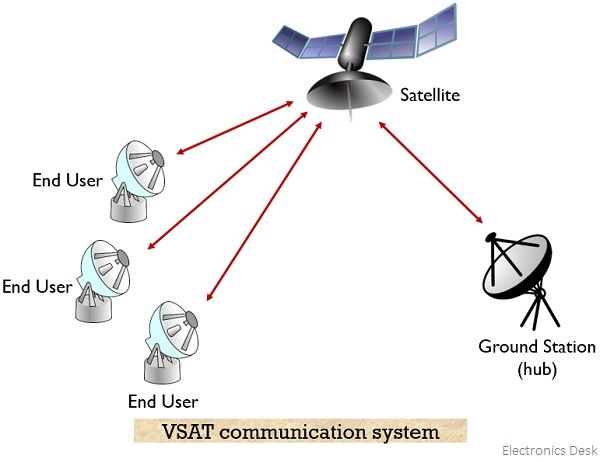VSAT is an acronym used for Very Small Aperture Terminal. It is a dual-way ground station that has a small antenna and is used for the purpose of transmitting and receiving the data to and from the satellite orbiting earth in space. The data from the ground station is provided to the satellite through VSAT and also the data coming from the satellite is provided to the end users with the help of VSAT.
Generally, the height of these antennas lies between 75 cm to 1.2 m. VSAT offers low data rate operation that ranges between 64 kbps to 128 kbps.
Content: VSAT
VSAT technology
In our previous contents, we have already discussed that a satellite is used to receive the signal coming from the ground and retransmit to the various locations on the ground relative to various applications. Thus, the specifically small terminals present at the ground-based stations that perform the task of transmitting the signal to the satellite and receiving the one coming from satellites are referred to as very small aperture terminal.
VSAT technology supports services like the internet, LAN, IP, voice, video, and data communication thus, it is beneficial for building up powerful public as well as a private network for reliable communication.
Importance of VSAT
Generally, it goes without saying that, in a communication link, the thing which is more importantly considered than signal level is signal to noise ratio. We know that noise varies in direct proportionality with the bandwidth utilization. But less bandwidth is required for low data rate and high bandwidth is needed for high data rate. Thus, in case of low data rate, the noise power will also be low and hence for receiving such a signal, a low gain antenna is required at the receiver terminal. And a low gain antenna needs an antenna with a small aperture.
Thus, such small aperture antennas usually with a diameter between 1 to 2 m come under VSATs. This means the basic feature possessed by the VSAT system is an antenna unit with a very small diameter at the earth station. And so, according to the recently discussed feature of VAST that it is suitable for low data rates, these are majorly used for establishing direct communication between various offices in a network.
Block Diagram of Very Small Aperure Terminal
The figure given below represents the block diagram representation of the VSAT transmitter and receiver:
The antenna unit of VSATs is placed on the top of a building and to have maximal gain to system noise temperature of the receiving system at the initial phase, a low noise amplifier is placed closer to the antenna so as to reduce or eliminate the cable losses before pre-amplification takes place.
Considering the transmitter section, at the very beginning, a source of data is present which is followed by a modulator, and then a UP converter is placed. The signal at the output of the UP converter is a power amplifier. While in the receiver section, there is a preamplifier placed near the antenna, the amplified signal from the LNA is down-converted and then a demodulating unit provides the original message signal. The signal obtained from the demodulator is provided to a baseband processor that acts as the last unit to process the received data and provide it to the end user.
How does a VSAT network operate?
Recently we have discussed the block diagram representation of a single VSAT having an outdoor and indoor unit for transceiver operation. However, there are various VSATs present in a VSAT network that forms interconnection with the hub station. VSAT network has a various number of terminals through which the satellite communicates.
The two most common network configurations in which various VSATs within a network are connected are:
- Star Network
- Mesh Network
The VSAT technology offers transmission and reception of data by antennas having small terminals thus the antenna terminals can be installed at various distributed locations and these form connections with the central hub via satellite. Basically, the VSAT network allows the data coming from the satellite to get redirected to various remote terminals over the earth.
It operates in a way that the satellite transponder sends a signal towards the transceiver where it receives the signal and the ground station behaves like a hub for the complete network. Through that hub, the complete network is controlled. The figure below represents the interconnection of various end users through the ground station via satellite in the form of a star network.
In order to have communication between end users, the actual signal is provided to the central hub and the hub then broadcasts it to the various VSATs in the network with the involvement of the satellite. For the transmission and reception of the signals, some multiple access methods are used. Each end user has its own VSAT. It is to be noted here that due to interconnection of VSATs via hub propagation delay as well as satellite capacity requirement also increases.
In a star network, the double-hop circuit is required however, a mesh network involves a single-hop network.
Generally, time division multiple access is used in the downlink mode where a signal from the hub is provided to the individual VSATs. However, offers low efficiency for the uplink mode. FDMA is also famous within the VSAT network.
But the most favorable technique is DAMA. DAMA stands for demand assigned multiple access and suits the operation of the VSAT network because in a VSAT system there exists bursty traffic which is non-continuous in nature. In the DAMA technique, assigning of transponder channels is done according to the data priority on the first come first serve format. Here a continuous connection is not built between the control station and user terminals however, once a frequency band is allotted to a specific terminal then that particular band will only be allotted to other terminals after the session completion of the former.
Basically, the services for data transmission and reception involved in the VSAT network are some kind of credit verification or reservation requests and these are quite random and spontaneous in nature. Hence, allotting time or frequency to perform TDMA or FDMA respectively will somewhat make the channel utilization improper.
Sometimes CDMA in coupling with ALOHA protocol is also used where data packets are transmitted randomly at different time slots.
Advantages
- Eliminates the use of a large physical network: In VSATs, signals from the satellite is not transported via any physical link like Ethernet cable but is allowed to get bounded by the orbital satellite. Thus the chances of structural issues are completely eliminated here along with infrastructural needs.
- Independent operation: VSAT systems offer independent operation for various local telecommunication networks where backup systems are not required to be set up. However, it is used as a backup for a wired network as when the wired network failure occurs then the operation may continue with the use of VSAT.
- Ease in deployment: The most advantageous factor of VSATs is their ability to get installed at remote locations without the need for much infrastructure. This is so because signals coming from satellites can be redirected to various locations via the hub.
Disadvantages
- Latency: Its major drawback is latency as signals undergo time delay while reaching the ground from a space-based body. This lag is majorly noticed when there is back and forth communication.
- Change in signal quality: Sometimes the change in weather conditions also changes the quality of signal transmitting between the satellite and earth station. While sometimes distortion occurs due to the presence of obstructions like buildings or trees in the path of data transmission.
Applications of Very Small Aperture Terminal
The various applications of very small aperture terminals are as follows:
- In banking and financial institutions.
- In mobile maritime communication.
- In data management and high-frequency trading.
- Billing system
- In navigation
- Medical consultancy services.
- ISDN services
- File transferring system and database enquiry system.
- E-mail or computer communications.
- Credit card transactions.
- Video conferencing
- Controlling and management such as stock.
- Airline and hotel booking.
- In large retail outlets.
A noteworthy point over here is it offers transmission and reception of narrowband as well as wideband data. The narrowband include credit card transactions, RFIS data, SCADA operation, etc. While wideband includes video conferencing, satellite accessing to remote locations, etc.